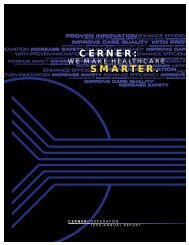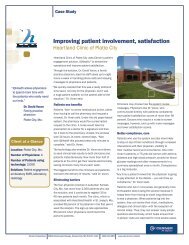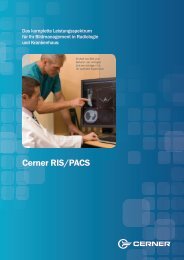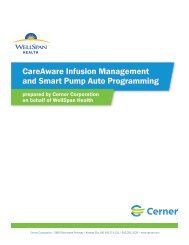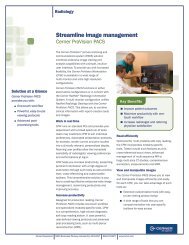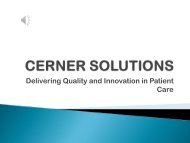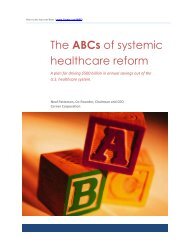The ABCs of systemic healthcare reform - Cerner Corporation
The ABCs of systemic healthcare reform - Cerner Corporation
The ABCs of systemic healthcare reform - Cerner Corporation
- No tags were found...
You also want an ePaper? Increase the reach of your titles
YUMPU automatically turns print PDFs into web optimized ePapers that Google loves.
Liquidity and Capital Resources<br />
<strong>The</strong> Company's liquidity is influenced by many factors, including the amount and timing <strong>of</strong> the Company's revenues, its cash<br />
collections from its clients and the amounts the Company invests in s<strong>of</strong>tware development, acquisitions and capital<br />
expenditures.<br />
<strong>The</strong> Company’s principal source <strong>of</strong> liquidity is its cash, cash equivalents and short-term investments. <strong>The</strong> majority <strong>of</strong> the<br />
Company’s cash and cash equivalents consist <strong>of</strong> money market funds. At January 3, 2009 the Company had cash and cash<br />
equivalents <strong>of</strong> $270,494,000, short-term investments <strong>of</strong> $38,400,000 and working capital <strong>of</strong> $517,650,000 compared to cash<br />
and cash equivalents <strong>of</strong> $182,914,000, short-term investments <strong>of</strong> $161,600,000 and working capital <strong>of</strong> $530,441,000 at<br />
December 29, 2007.<br />
At January 3, 2009, more than 10 percent <strong>of</strong> total net receivables represent accounts receivable and contracts receivable<br />
related to a contract with Fujitsu that was terminated in the second quarter <strong>of</strong> 2008 when Fujitsu withdrew from the National<br />
Health Service (NHS) initiative to automate clinical processes and digitize medical records in the Southern region <strong>of</strong> England.<br />
<strong>The</strong> Company expects to collect these receivables in full based on the terms <strong>of</strong> the contract.<br />
At January 3, 2009, the Company held auction rate securities with a par value <strong>of</strong> $105,300,000 and an estimated fair value <strong>of</strong><br />
$85,440,000. In February and March 2008, liquidity issues in the global credit markets resulted in the progressive failure <strong>of</strong><br />
auctions representing all the auction rate securities held by <strong>Cerner</strong>. <strong>The</strong>se conditions persisted through the remainder <strong>of</strong> 2008<br />
and into 2009. In November 2008, the Company entered into a settlement agreement with the investment firm that sold the<br />
Company its auction rate securities. Under the terms <strong>of</strong> the settlement agreement the Company received the right to redeem<br />
the securities at par value during a period from mid-2010 through mid-2012. <strong>The</strong> right to redeem the securities is being treated<br />
similar to a put option, which the Company has elected to measure under the fair value option <strong>of</strong> Statement <strong>of</strong> Financial<br />
Accounting Standards No. 159 (SFAS No. 159), “<strong>The</strong> Fair Value Option for Financial Assets and Financial Liabilities.” <strong>The</strong><br />
Company’s valuation model resulted in a pre-tax, estimated value <strong>of</strong> $19,860,000 for the value <strong>of</strong> the put-like settlement<br />
feature, which such gain was recognized through other income.<br />
Concurrently with the recognition <strong>of</strong> the put-like feature, the Company transferred the auction rate securities from available-forsale<br />
to trading securities. As a result <strong>of</strong> the transfer, the Company recognized a pre-tax, other than temporary impairment loss<br />
<strong>of</strong> approximately $19,860,000 in other income. <strong>The</strong> recording <strong>of</strong> the put-like feature and the recognition <strong>of</strong> the other than<br />
temporary impairment loss on the securities resulted in no impact to the Consolidated Statements <strong>of</strong> Operating Earnings for the<br />
year ended January 3, 2009. <strong>The</strong> Company anticipates that any future changes in the fair value <strong>of</strong> the put-like feature will be<br />
<strong>of</strong>fset by the changes in the fair value <strong>of</strong> the related auction rate securities with no material net impact to the Consolidated<br />
Statements <strong>of</strong> Earnings. For a more detailed discussion <strong>of</strong> the auction rate securities situation, please refer to Note (7) to the<br />
consolidated financial statements. <strong>Cerner</strong> does not expect the auction failures to impact the Company’s ability to fund its<br />
working capital needs, capital expenditures or other business requirements.<br />
Cash Flows from Operating Activities<br />
<strong>The</strong> Company generated cash <strong>of</strong> $281,802,000, $274,565,000, and $232,718,000 from operations in 2008, 2007, and<br />
2006, respectively. Cash flow from operations increased in 2008 due primarily to the increase in net earnings which was<br />
partially <strong>of</strong>fset by changes in working capital. <strong>The</strong> Company has periodically provided long-term financing options to<br />
creditworthy clients through third party financing institutions and has directly provided extended payment terms to clients from<br />
contract date. <strong>The</strong>se extended payment term arrangements typically provide for date based payments over periods ranging<br />
from 12 months to seven years. Pursuant to SOP 97-2, because a significant portion <strong>of</strong> the fee is due beyond one year, we have<br />
analyzed our history with these types <strong>of</strong> arrangements and have concluded that we do have a standard business practice <strong>of</strong><br />
using extended payment term arrangements and have a long history <strong>of</strong> successfully collecting under the original payment terms<br />
for arrangements with similar clients, product <strong>of</strong>ferings and economics without granting concessions. Accordingly, we consider<br />
the fee to be fixed and determinable in these extended payment term arrangements and, thus, the timing <strong>of</strong> revenue is not<br />
impacted by the existence <strong>of</strong> extended payments. Some <strong>of</strong> these payment streams have been assigned on a non-recourse<br />
basis to third party financing institutions. <strong>The</strong> Company has provided its usual and customary performance guarantees to the<br />
third party financing institutions in connection with its on-going obligations under the client contract. During 2008, 2007, and<br />
2006, the Company received total client cash collections <strong>of</strong> $1,729,526,000, $1,646,584,000, and $1,457,603,000,<br />
respectively, <strong>of</strong> which approximately 5%, 5%, and 7% were received from third party client financing arrangements and nonrecourse<br />
payment assignments, respectively. <strong>The</strong> days sales outstanding increased to 92 days for the quarter ended January 3,<br />
2009 compared to 90 days for the quarter ended December 29, 2007. Revenues provided under support and maintenance<br />
agreements represent recurring cash flows. Support and maintenance revenues increased 19% in 2008 and 17% in 2007, and<br />
the Company expects these revenues to continue to grow as the base <strong>of</strong> installed <strong>Cerner</strong> Millennium systems grows.<br />
Cash Flows from Investing Activities<br />
Cash used in investing activities in 2008 consisted primarily <strong>of</strong> capital purchases <strong>of</strong> $108,099,000, which includes<br />
$89,904,000 <strong>of</strong> capital equipment and $18,195,000 <strong>of</strong> land, buildings and improvements. Capitalized s<strong>of</strong>tware development<br />
costs were $70,098,000 in 2008. Payments aggregating $5,719,000 were made during 2008 for an acquisition <strong>of</strong> a business<br />
and an earnout payment related to a 2005 acquisition. Cash received from short-term investments, net <strong>of</strong> purchases was<br />
$17,510,000 in 2008. Cash used in investing activities in 2007 consisted primarily <strong>of</strong> capital purchases <strong>of</strong> $180,723,000,<br />
which includes $105,678,000 <strong>of</strong> capital equipment and $75,045,000 <strong>of</strong> land, buildings and improvements. Capitalized<br />
45



